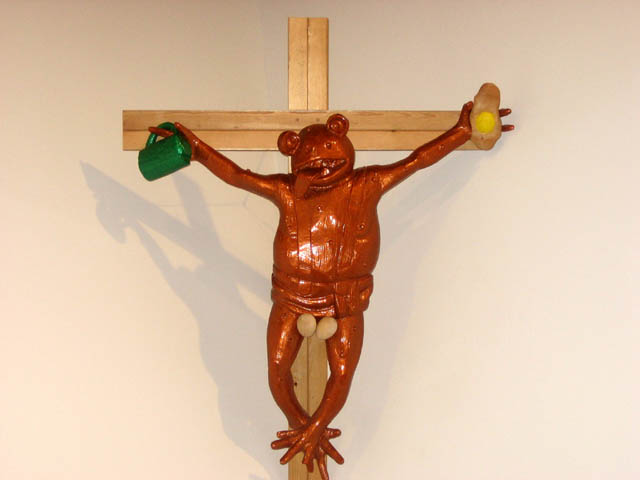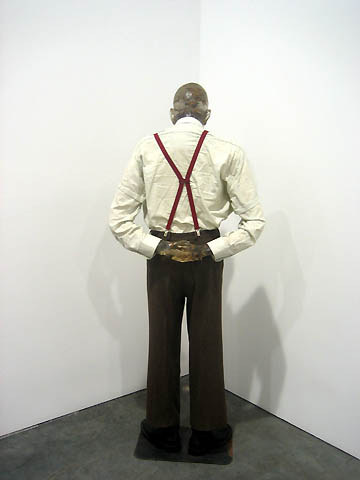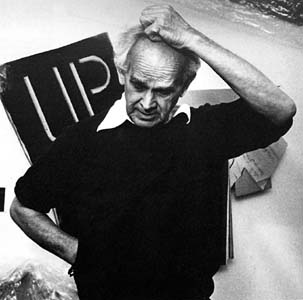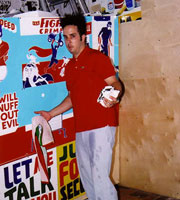A New "Sensation"?: Kippenberger's Crucified Frog Condemned by Catholics

Museum officials have insisted on their institutional autonomy and freedom of expression, while various clergy, government functionaries and Vatican spokesmen, even Pope Benedict XVI himself, have denounced it as provocative and blasphemous, and demanded its removal. To support this there have been various actions, including a hunger strike by a local politician, a petition signed by 10,000 citizens, and a protest march.
In response, the frog was moved from the entrance hall to the third floor, and at one point partially obscured by newspaper stories about the controversy. But apparently nothing short of its total removal will be acceptable to its critics.

Following is a news thread on the controversy.
Artforum.com, August 29, 2008
An Italian museum rejected a request from Pope Benedict XVI to remove a sculpture of a crucified green frog, Reuters reported via the New York Times. The work, which depicts the frog holding a beer mug and an egg, was condemned by the Vatican as blasphemous. The board of the Museion Museum in the northern city of Bolzano decided by a majority vote that the wooden sculpture, by the German artist Martin Kippenberger, would stay in place for the remainder of the exhibition in which it is included. The Vatican wrote a letter of support in the pope’s name to Franz Pahl, the president of the regional government, who opposed the sculpture. “This decision to keep the statue there is totally unacceptable,” Pahl said. “It is a grave offense to our Catholic population.” Alois Lageder, the museum’s president, said the decision to continue to display the statue was made to “safeguard the autonomy of art institutions.”DesignBoom.com, August 29, 2008
a one-metre high sculpture of a crucified frog, holding a mug of beer and an egg, on show at a modern art museum in italy has stirred controversy in the staunchly roman catholic country. the frog, with its tongue hanging out is wearing a green loin cloth and is nailed through the hands and feet on a brown cross in the manner of jesus christ and could be perceived as a provocation by the people of the alto adige region, which is 99% catholic. the board of the 'museion' museum in the city of bolzano was meeting today to decide whether to comply with the wishes of the pope, who is currently on holiday in the bolzano region.Artforum, August 5, 2008
curators at bolzano museum of modern art 'museion' said that kippenberger’s work was a self-portrait of the artist ‘in a state of profound crisis’, but their explanation has been given short shrift by local bishop wilhelm egger. ‘the crucified frog has shocked many visitors to the 'museion' and has hurt their religious feelings,’ egger said. the debate about this controversial artwork started when an italian official started a hunger strike.
Franz Pahl—an Italian politician from South Tyrol—has ended his hunger strike. As Der Standard reports, the politician began his strike one week ago to protest the exhibition of a work by Martin Kippenberger in the new Museion in Bolzano, the capital of the South Tyrol region. Kippenberger’s sculpture features a crucified frog holding a beer in one hand and an egg in the other. According to the report, Pahl suffered a fainting spell during his strike and was taken to the hospital. Although his condition was “not critical,” the politician was kept under observation.ARTINFO, July 30, 2008
BOZEN, Italy—A debate about a controversial artwork has reached a new level in Italy.
Last week, Franz Pahl, an elected official in the country's South Tyrol region, began a hunger strike protesting a Martin Kippenberger artwork that depicts a crucified frog holding a mug of beer in one hand and an egg in the other, reports Der Standard.
Pahl has said that he'll continue the strike until the work, on view in the new, state-funded Museion Museum of Modern and Contemporary Art in Bozen, is removed. Curator Letizia Regaglia has thus far refused to do so. The work is scheduled to be on display until September 21.
Pahl, who's been camping out in front of the museum overnight, says it's "schizophrenic" to invite the Pope to visit the region while displaying such a "perversion of the Christian cross" in a state-funded museum. The pope is spending his summer in nearby Bressanone.
Andreas Pöder, another elected official in the local government, called the strike hypocritical, pointing out that Pahl had said two months earlier that the work didn't bother him. Other critics have suggested that Pahl is politicizing the debate to boost his image leading up to regional elections in the fall.
Kippenberger, for his part, felt crucified himself during the making of the work, according to Regaglia. He was beginning a detoxification from alcohol and drugs and going through severe withdrawal at the time.
Arcadja, June 10, 2008
Recently Italy has been proving to be a rather “sanctimonious” country towards contemporary art. In short, we are before a nation that is shocked ridiculously by old artistic ideas. For instance, the case of the crucifixion theme: inventing a variation on the theme of the Christ’s death is sure to cause a polemic. History is full of this type of examples. Last in order of time is Maurizio Cattelan’s crucified woman with her back turned to the public, inside a wooden case attached to the external wall of an ex-synagogue at about four meters from the floor. Besides raising objections against Cattelan’s magnificent work, the Italian art system has recently been inveighing against a work by German artist Martin Kippenberger displayed at the Museion, the newborn museum of contemporary art in Bolzano.
It is “Zuerst die Füße” (first the feet), the sculpture dated from 1990, which measures about a meter and represents a crucified frog holding in its right hand a mug of beer and in its left hand an egg. In this work Kippenberger represents a society that appears perfect but is actually hypocritical. A society that at the end of the day stoops to drinking beer in bars and unbends to distasteful cracks about sex and foul words. In short, the frog on the cross represents men reduced to animals, that drink to the point of demeaning themselves, that cannot free themselves from the cross of alcohol lived as a plague. And Kippenberger condemns a society that, on the one hand claims to be Christian and on the other, right under and before the Christ that it reckons to venerate, can only express its worst side. The frog is man demeaned by beer and alcohol, constantly “nailed” by (or with the fixation of) sex, while the egg represents the betrayed perfection. An agonizing and blasphemous work, almost a farce, with a carnival puppet, in an evocative dimension that desecrates and shocks. But the crucified frog has been strongly attacked and has stirred many polemics. Even before the political and religious reactions, visitors protested and asked for information so frequently that the museum staff had to do a sort of improvised mini-course for the gallery personnel with the basic information about the artist and the meaning of the work; as Antonio Lampis sums up “a crucifixion is always an invitation to reflect on suffering” – claiming that – “in any event of contemporary art you will find more or less strong works on religion. It is part of people’s life, it is normal for it to become an ingredient of art. Society is getting used to being hypersensitive about certain themes but nobody can feel offended by a work of art”. However, there are many people who feel offended by all this.
On Sunday 1st June, the Schuietzens native of Alto Adige organized a protest march in Bolzano, in occasion of the Sacred Heart festivity. The crucified frog was attacked by many because it is considered an outrage against religion. Among the people who requested the removal of the work of art (which for now has not happened), there was also province governor Luis Durnwalder who, after pointing out that it is not up to politics to judge art, said that the work “could be felt as a provocation by the people of Alto Adige, which is 99% catholic”. Therefore, Durnwalder proposed putting the work aside and developing careful consideration about it. The event was critically remarked on also by bishop Wilhelm Egger, who deemed the work to be offensive towards religious principles. Objections have also arrived from some parties connected to National Alliance, which recalled recent polemics about a work portraying a flush provided with Mameli’s national anthem as soundtrack.
The case has also been assessed by the ecclesiastic apex. The general secretary of the Cei, Mons. Giuseppe Betori, talked about a work that “offends the religious feelings of most Italian people” and said that “this episode cannot be left unspoken about”. According to Betori, more generally, “the world of art has lost its dialogue with the world of religion”. Even the Executive Committee of the diocesan pastoral Council of Bolzano has taken a stand claiming that the crucified frog is “offensive and humiliating”. “Art needs its space and it is fair that it has it – claimed the Committee in a release – modern art is per se provocative. This, however, must not become an excuse to upset people’s religious feelings, by mocking the cross, which is an important symbol for Christians. Therefore, the Committee hopes that the Museion will become a place where art, religion and culture can dialogue in a constructive and respectful way.

Nicole Davis wrote on the exhibition in Artnet in October 2005.
His self-defacement, while sad, is the humorous and sardonic crux of his work. Kippenberger was an excessive alcoholic, and many believe the poison drove him to his death. Beer mugs and cocktail glasses are regular features of his works, like familiar relatives. The ups and downs of alcoholism are mapped out, too, in his physical appearance, ranging from "Helmut Berger on a good day" to a fat bearded man on the verge of death, each version depicted with his unique but odd combination of self-reverence and irreverence.
Kippenberger's semiology is one part seriousness and three parts humor. His alter ego "Fred the Frog", who appears on canvas and in sculpture alike, is at the same time a comic stand-in for Jesus, and as a spoof on all religious fervor. Luhring Augustine has a version of Kippenberger's frog on a cross (1990), where Fred the Frog is hammered (literally and figuratively) to a crucifix with a beer stein in his hand. The translation of the title to English is approx. "What's the difference between Casanova and Christ, when they get nailed the expression is the same."
Ridiculing as well anti-religious sentiment, The Cross of a Frog is also a satanic ritual outlined by occultist Alistair Crowley's in his book of "Libers." In reference to the frog he orders, "During the day thou shalt approach the frog whenever convenient, and speak words of worship. Also thou shalt promise to the frog elevation fitting for him; and all this while thou shalt be secretly carving a cross whereon to crucify him." The sadism here is transformed to masochism, as the frog is a form of Kippenberger himself. The ritual continues its instructions uncannily "Then shalt thou stab the frog to the heart with the Dagger of Art." Kippenberger's cross is actually made out of the wood used for canvas stretchers. The artist, one presumes, used his art to crucify himself, but at the same time it liberated him and allowed him to engage with the world.

Kippenberger explored the same theme in other work. Fred the Frog Rings The Bell, an edition of seven (plus three artist's proofs), was also completed in 1990. It is less than half the height of the original Feet First, with the egg transposed under the arm and the whole piece finished in a single matte brown, as distinct from the glazed surfaces and detailed coloring seen above.
An infamous Kippenberger sculpture, Martin, go in the corner, shame on you (1989), might also seem relevant at this juncture. A self portrait with humorously abject connotations, the artist ironically acknowledges his bad boy persona with a characteristic mixture of audacity and self loathing. The hunched shoulders, hands clasped behind his back and reverse figuration all suggest a rueful awareness, the acceptance of an unavoidable legacy of misunderstanding, punishment and "crucifixion".

UPDATE: From Artforum.com:
POPE DID NOT SPEAK AGAINST KIPPENBERGER SCULPTURE



































